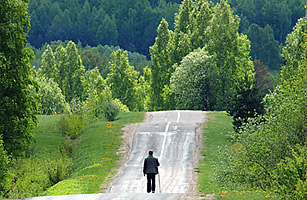
Having tucked into his first bottle of vodka earlier than usual, Anatoly Zhbanov goes on an afternoon stroll to buy another one along the dirt road through Lopotova, a dying village on Russia’s western edge, in the region of Pskov. It is mid-April, and clumps of snow are still melting at the roadside where Zhbanov, a local artist, stops to peer inside a lopsided cabin, the home of a local bootlegger. In the window stands a plastic jug filled with murky liquid, its neck sealed with a rubber glove that seems to be waving hello. “That’s how you know it’s ready,” Zhbanov says. “The gas released from fermentation makes the glove inflate. We call that the Hitler Salute.”
In the past few years, the region of Pskov has become famous in Russia for two interconnected blights: moonshine and depopulation. In 2006, a brew tainted with chemicals killed at least 15 people and poisoned hundreds, marking the first time a Russian region had to declare a state of emergency because of vodka. Last month, when the federal government released the census data collected in 2010, Pskov earned another claim to fame. It is dying out faster than any other region in Russia’s heartland.
Of course the rest of the country isn’t doing so well either. The population has dropped by 2.2 million people, or 1.6%, since the last census was taken in 2002. These were supposed to have been the glory years under Vladimir Putin, who has ruled Russia since 2000, first as president and now prime minister. And in that time, a handful of cities have indeed prospered, with Moscow becoming home to more billionaires than any other city in the world. But more than 6,000 villages have meanwhile turned into ghost towns, or as the census calls them: “population points without population.” About 2,000 of those are in Pskov.
In just eight years, the region has lost 11.5% of its population, a rate of decline more often seen in times of war and famine. This might have been expected in Russia’s permanently frozen north, like the region of Magadan, once home to the Gulag prison camps, where the population dropped 14.1% in that time. But Pskov lies on the border with the European Union, and the city of St. Petersburg, Putin’s birthplace, is only 100 miles away.
In Soviet times, huge collective farms and machine works were based in Pskov. Village life thrived, and the main city was still famed for nobler things, like fending off the Teutonic Knights in the 13th century. But traveling the region’s backroads now inspires the creepy feeling that a plague has just passed through. Every few miles a cluster of huts emerges from behind a hill, and most of them turn out to be abandoned, their floorboards warped and splintered, releasing a smell of decay. The fields are overgrown, and old grain elevators tower over them like enormous ghosts — landmarks to Russia’s demographic catastrophe.
So by local standards, the village of Lopotova is doing fairly well. The villagers say it still has a few hundred residents as well as its own grocery store, where the saleswoman spends most of the day ringing up liquor sales on an abacus. No surprise that the most popular item is vodka, the cheapest half-liter bottle going for 68 rubles, or $2.25. Far from everyone can afford it.
Behind the store, at the end of the unmarked village road, Zhbanov comes across a group of five young men in their 20s sitting on a log in front of a sheet-metal shack. They are not homeless, but they look it. In a week or so, the weather will let them pick mushrooms and berries to sell on the side of the road, the steadiest form of employment they have had since 2003, when the local farm went bankrupt. Aside from that, they can forage for scrap metal or go talk to Zhbanov, who makes enough selling his paintings in St. Petersburg to give them a handout from time to time.
One of the men, a native of Lopotova named Alik Matveev, scratches his head when asked the last time he had seen any sign of the government. “I can’t really remember,” he says. “There’s no hospital, and our school closed in 2006. I guess that was a government building.”
That was also the year Putin imposed the policy of per-capita financing for education, which meant that schools with too few students could not afford to stay open. In many sparsely populated regions, this crippled the education system, and young families fled to the cities to put their children in school. Many ended up in Moscow, boosting the city’s population since 2002 by 10.9% to 11.5 million people, according to the census.
See 10 things to do in Moscow.
See why hackers hit Russia’s most popular blogging service.